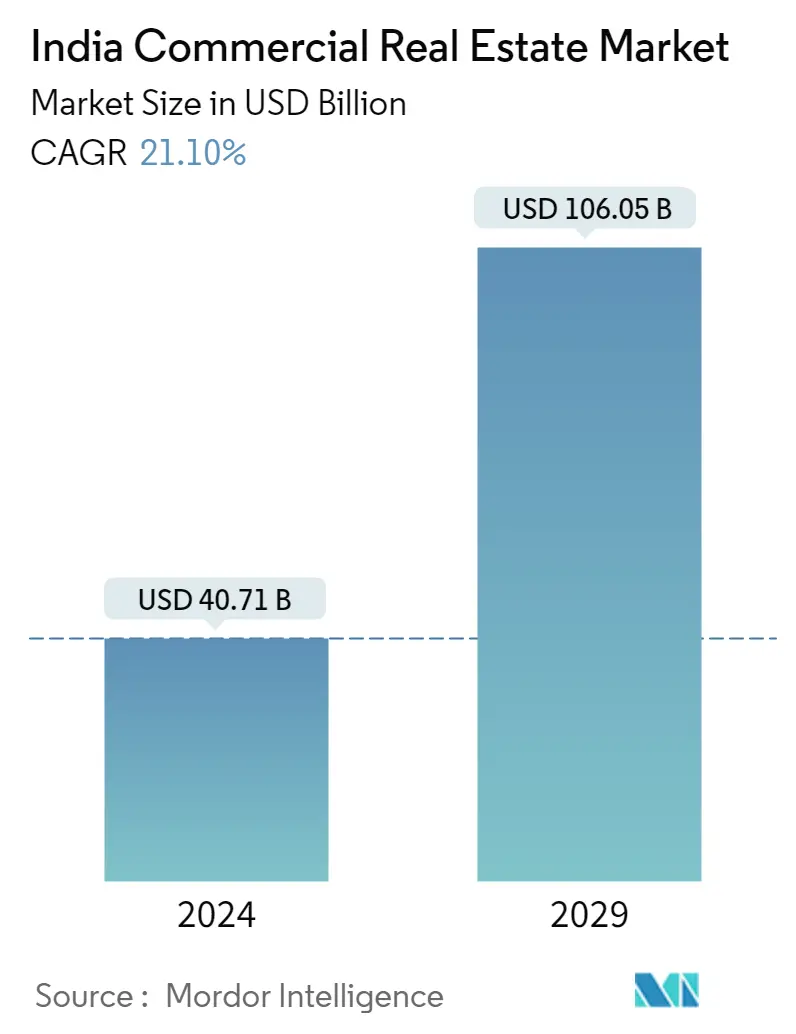Market Size of India Commercial Real Estate Industry

| Study Period | 2020 - 2029 |
| Base Year For Estimation | 2023 |
| Market Size (2024) | USD 40.71 Billion |
| Market Size (2029) | USD 106.05 Billion |
| CAGR (2024 - 2029) | 21.10 % |
| Market Concentration | Low |
Major Players
*Disclaimer: Major Players sorted in no particular order |
India Commercial Real Estate Market Analysis
The India Commercial Real Estate Market size is estimated at USD 40.71 billion in 2024, and is expected to reach USD 106.05 billion by 2029, growing at a CAGR of 21.10% during the forecast period (2024-2029).
- The COVID-19 pandemic resulted in the work-from-home (WFH) culture, which had a short-term impact on new space obligations. In 2022 New office space in the seven cities ((Mumbai, Delhi NCR, Bengaluru, Hyderabad, Chennai, Kolkata, and Pune) in India was 38.25 million sq. ft that year, down by 30% from the previous year. In the first quarter of 2023 (January-March), net office absorption in the top six cities stood at 8.3 million sq. ft.
- According to industry experts, from September 2022, grade A offices in Indian cities, such as Bengaluru and Mumbai, had an average cap rate of 8.25 in core locations. In comparison, the cap rate of grade A offices in Taipei was 2.35 on average that year. As of the second quarter of that year, other regions of Gurugram had the highest vacancy rate combined at 35.9%. In comparison, the Cybercity of Gurugram in India had a vacancy rate of 5.4%, the lowest amongst other submarkets of the Delhi NCR region, according to industry experts.
- Retail and hospitality are also growing significantly in the commercial real estate market, providing the much-needed infrastructure for India's growing needs. India's commercial real estate sector is projected to be accelerated by large-scale investments by institutional investors in the coming years. The retail real estate sector in the country has been dramatically boosted by government initiatives, such as Make in India, and other reforms in the realty sector, such as the introduction of the Real Estate Regulatory Authority (RERA) and GST.
- Despite their initial troubles, developers and buyers are moving to the commercial real estate sector due to the transparency and competence of the industry, which has attracted increasing amounts of foreign direct investments (FDI) in commercial estate. The country's economic growth is driving demand for commercial property. Government initiatives and urban development policies and programs (Smart City, AMRUT) are expected to contribute to the need for real estate infrastructure.
- The demand for office space in the nation is driven by reasons such as flexibility, comfort, and convenience. Most businesses in various industries, including IT, manufacturing, BFSI, startups, and even boutique businesses, are looking for office space to accommodate their employees. Additionally, many companies intend to expand to new areas, open remote or satellite offices, or both, adding to the demand for these spaces.
- Technology development has elevated commercial real estate to a new level. It is now feasible to offer virtual property tours, improve customer relationship management, conduct online transactions, and improve communication between the seller and the buyer thanks to cutting-edge technology like artificial intelligence, virtual reality, and data analytics.
India Commercial Real Estate Industry Segmentation
Commercial real estate (CRE) is only used for business-related activities or to offer a workspace, as opposed to being utilized as a residence, which would fall under the residential real estate category. Most frequently, renters lease commercial real estate to conduct businesses that generate cash.
A complete background analysis of the India Commercial Real Estate Market, including the assessment of the economy and contribution of sectors in the economy, market overview, market size estimation for key segments, and emerging trends in the market segments, market dynamics, and geographical trends, and COVID-19 impact is included in the report. The India Commercial Real Estate Market is Segmented by Type (Offices, Retail, Industrial and Logistics, and Hospitality) and By Key Cities (Mumbai, Bangalore, Delhi, Hyderabad, and Other Cities). The report offers market size and forecasts for the Commercial Real Estate Market in India in value (USD) for all the above segments.
| By Type | |
| Offices | |
| Retail | |
| Industrial and Logistics | |
| Hospitality |
| By Key Cities | |
| Mumbai | |
| Bangalore | |
| Delhi | |
| Hyderabad | |
| Other Cities |
India Commercial Real Estate Market Size Summary
The commercial real estate market in India is poised for significant growth, driven by a combination of economic recovery, technological advancements, and increasing demand for flexible workspaces. The sector, which includes office, retail, and hospitality spaces, is experiencing a resurgence as businesses adapt to post-pandemic realities. The shift towards hybrid work models and the rise of co-working spaces are reshaping the demand for office properties, with sectors such as IT, BFSI, and e-commerce leading the charge. Government initiatives and urban development programs are further bolstering the market, attracting substantial investments from institutional and foreign investors. The introduction of regulatory reforms like RERA and GST has enhanced transparency, making the sector more appealing to global investors.
The market landscape is characterized by a mix of established players and emerging opportunities, with major companies like DLF, Godrej Properties, and Oberoi Realty playing pivotal roles. The retail real estate segment is witnessing increased interest due to robust office space uptake and declining vacancy rates. Technological innovations, such as occupancy sensing and data analytics, are enhancing decision-making and improving the workplace experience. Strategic partnerships, like the joint venture between CPP Investments and TATA Realty, are set to further expand the commercial office space portfolio in India. As the market continues to evolve, the focus on sustainability and smart city initiatives is expected to drive future growth, positioning India as a key player in the global commercial real estate arena.
India Commercial Real Estate Market Size - Table of Contents
-
1. MARKET INSIGHTS AND DYNAMICS
-
1.1 Market Overview
-
1.2 Commercial Real Estate Buying Trends - Socioeconomic and Demographic Insights
-
1.3 Government Initiatives and Regulatory Aspects for Commercial Real Estate Sector
-
1.4 Insights on Existing and Upcoming Projects
-
1.5 Insights on Interest Rate Regime for General Economy and Real Estate Lending
-
1.6 Insights on Rental Yields in the Commercial Real Estate Segment
-
1.7 Insights on Capital Market Penetration and REIT Presence in Commercial Real Estate
-
1.8 Insights on Public-Private Partnerships in Commercial Real Estate
-
1.9 Insights on Real Estate Tech and Startups Active in the Real Estate Segment (Broking, Social Media, Facility Management, Property Management)
-
1.10 Impact of COVID-19 on the Market
-
1.11 Market Drivers
-
1.11.1 Increasing need for contemporary office spaces
-
1.11.2 Urban and semi-urban lodging are acting as other significant growth-inducing factors
-
-
1.12 Market Restraints
-
1.12.1 Availability of Financing
-
-
1.13 Market Opportunities
-
1.13.1 Foreign investment
-
-
1.14 Industry Attractiveness - Porter's Five Forces Analysis
-
1.14.1 Bargaining Power of Suppliers
-
1.14.2 Bargaining Power of Consumers / Buyers
-
1.14.3 Threat of New Entrants
-
1.14.4 Threat of Substitute Products
-
1.14.5 Intensity of Competitive Rivalry
-
-
-
2. MARKET SEGMENTATION
-
2.1 By Type
-
2.1.1 Offices
-
2.1.2 Retail
-
2.1.3 Industrial and Logistics
-
2.1.4 Hospitality
-
-
2.2 By Key Cities
-
2.2.1 Mumbai
-
2.2.2 Bangalore
-
2.2.3 Delhi
-
2.2.4 Hyderabad
-
2.2.5 Other Cities
-
-
India Commercial Real Estate Market Size FAQs
How big is the India Commercial Real Estate Market?
The India Commercial Real Estate Market size is expected to reach USD 40.71 billion in 2024 and grow at a CAGR of 21.10% to reach USD 106.05 billion by 2029.
What is the current India Commercial Real Estate Market size?
In 2024, the India Commercial Real Estate Market size is expected to reach USD 40.71 billion.

